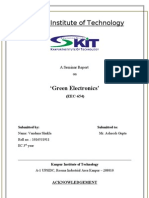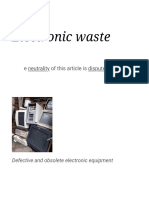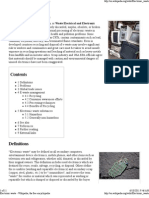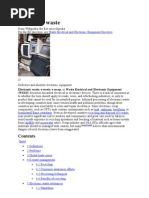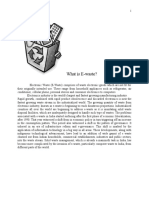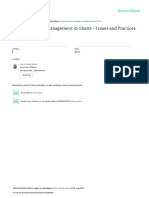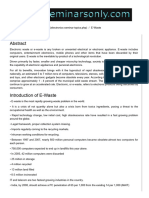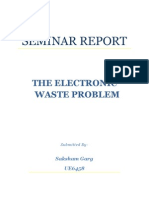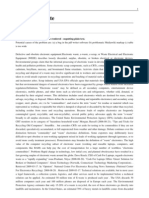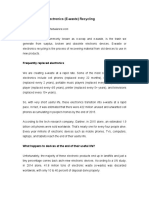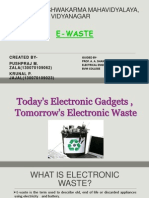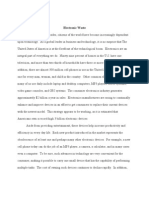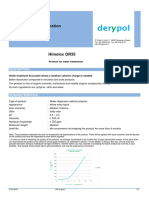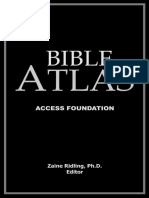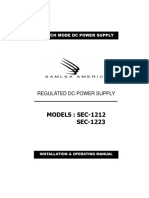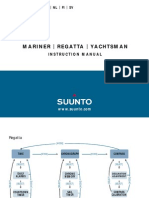ppc-ttv1
ppc-ttv1
Uploaded by
Wong Peng ChiongCopyright:
Available Formats
ppc-ttv1
ppc-ttv1
Uploaded by
Wong Peng ChiongCopyright
Available Formats
Share this document
Did you find this document useful?
Is this content inappropriate?
Copyright:
Available Formats
ppc-ttv1
ppc-ttv1
Uploaded by
Wong Peng ChiongCopyright:
Available Formats
“While millions of computers have been ‘junked’ over the past few
years, the rate of recycling has decreased due to a lack of effective
systems or policies. The industry’s ‘planned obsolescence’ policy of
frequently introducing upgraded products threatens to make the
disposal problem worse.”
– Ted Smith, Executive Director, Silicon Valley Toxics Coalition,
“Should PC Makers Recycle Wares?” – zdnet, June 24, 1999
CONTENTS
2 Executive Summary
6 Overview
7 What exactly is E-waste?
7 High Tech: A short life-cycle from helpful to harmful
8 How big is the problem?
9 Computers are toxic traps
10 What’s in our PCs? Table and diagram
12 Poisons in E-waste and their effects on us
15 Disposing of computers is hazardous
15 The hazards of burning computer junk
17 The hazards of recycling computer junk
18 E-waste exporting: The unknown, dangerous,
and secretive activity
19 How do computer manufacturers
respond to the challenge?
21 Costs of E-waste
22 What should be done?
25 Electronics Take it Back! platform
27 Endnotes
Toxic TVs and Poison PCs 1
Executive Summary
Electronic waste (E-waste) encompasses a broad and growing range of electronic devices ranging
from large household appliances such as refrigerators, washers and dryers, and air conditioners, to
hand-held cellular phones, fluorescent lamp bulbs (tubes), and personal stereos. Where once
consumers purchased a stereo console or television set with the expectation that it would last for a
decade or more, the increasingly rapid evolution of technology has effectively rendered everything
“disposable.” Consumers no longer take a malfunctioning toaster, VCR or telephone to a repair
shop. Replacement is often easier and cheaper than repair. And while these ever improving gadgets
– faster, smaller, cheaper – provide many benefits, they also carry a legacy of waste.
Electronic waste already constitutes from 2% to 5% of the US municipal solid waste stream and is
growing rapidly. European studies estimate that the volume of electronic waste is rising by 3% to
5% per year – almost three times faster than the municipal waste stream. 1
According to the US Environmental Protection Agency (EPA), in 1997 more than 3.2 million tons
of E-waste ended up in US landfills. In a new report for the EPA, analysts estimate that the amount
of E-waste in US landfills will grow fourfold in the next few years. 2
Over the last several years, no product so epitomizes the problems posed by obsolete electronics as
the personal computer. Due to their growing waste volume, toxicity and management cost, they
are the focus of this report. How California chooses to address the problems posed by obsolete
computers is likely to set the tone for the broader spectrum of E-waste.
1 The volume of obsolete computers thrown out or temporarily stored for later disposal is
already a serious problem that is escalating at a rapid rate.
Today’s computer industry innovates very rapidly, bringing new technologies and “upgrades” to
market on the average of every 18 months. The average life span of a personal computer has
shrunk from four or five years to two years. 3 Users in California buy more than 2.2 million new
computer systems each year. Currently, about 50% of US households own a computer. 4
Analysts estimate that more than 6,000 5 computers become obsolete in California every day. They
are either tossed out with the trash and subsequently landfilled by trash collectors – often illegally
– or stored in attics and garages for a later day when they will be dumped.
Consumers have, on average, 2 to 3 obsolete computers in their garages, closets or storage spaces.
US government researchers estimate that three-quarters of all computers ever sold in the United
States remain stockpiled, awaiting disposal. 6 Should every consumer attempt to throw out
their obsolete computer at once, California and the nation would face a major budgetary and
environmental crisis.
The crisis continues to grow. Studies estimate that the number of obsolete computers in the United
States will soon be as high as 315 to 680 million units. 7, 8 By the year 2005, one computer will
become obsolete for every new computer put on the market.
2 Recycling rates for computers are low – and opportunities are virtually nonexistent for most
California consumers.
The National Safety Council reported in 1999 that only 11% of discarded computers were recycled,
compared with 28% of overall municipal solid waste. 9 In California, estimates of computer
recycling range from 5% to 15%, compared to a 42% rate for overall solid waste and a 70% rate
for major appliances like refrigerators, washing machines, and dryers. 10
2 Toxic TVs and Poison PCs
For large commercial customers, computer system distributors may negotiate for the collection
and management of obsolete computer systems. However, there remains very little information on
where and if these computers are recycled.
For the individual consumer looking to properly manage an obsolete home or office computer,
options for recycling are virtually nonexistent. Recycling options that do exist typically come with
a price tag of $10 to $30 per unit.
3 Discarded computers are hazardous wastes – and when dumped into landfills or improperly
recycled, pose a hazard to the environment and human health.
The cathode ray tubes (CRTs) in computer monitors, television sets, and other video display
devices contain significant concentrations of lead and other heavy metals. The State of California
recently affirmed that:
“...when discarded, CRTs are identified as hazardous waste under both federal and State law and
are required to be managed in accordance with all applicable requirements, including generator,
transporter and facility requirements.” 11
Source: California Department of Toxic Substances Control
March 21, 2001, Letter to Materials for the Future Foundation
As a hazardous waste, the disposal of CRTs in municipal solid waste landfills is prohibited.
Additionally, collection, whether for recycling or disposal, must be regulated and permitted as a
hazardous waste activity.
Each computer or television display contains an average of 4 to 8 pounds of lead. 12 The 315
million computers that will become obsolete between 1997 and 2004 contain a total of more than
1.2 billion pounds of lead. 13 Monitor glass contains about 20% lead by weight. 14 When these
components are illegally disposed and crushed in landfills, the lead is released into the environ-
ment, posing a hazardous legacy for current and future generations. Consumer electronics already
constitute 40% of lead found in landfills. 15 About 70% of the heavy metals (including mercury
and cadmium) found in landfills comes from electronic equipment discards. These heavy metals
and other hazardous substances found in electronics can contaminate groundwater and pose other
environmental and public health risks. 16
Lead can cause damage to the central and peripheral nervous systems, blood system and
kidneys in humans. Lead accumulates in the environment, and has highly acute and chronic
toxic effects on plants, animals and microorganisms. Children suffer developmental effects
and loss of mental ability, even at low levels of exposure.
Other hazardous materials used in computers and other electronic devices include cadmium,
mercury, hexavalent chromium, PVC plastic and brominated flame retardants. Mercury, for
example, leaches when certain electronic devices such as circuit breakers are destroyed. The
presence of halogenated hydrocarbons in computer plastics may result in the formation of dioxin if
the plastic is burned. 17 The presence of these chemicals also makes computer recycling particu-
larly hazardous to workers, as well as the environment.
4 What should we do with obsolete computers?
Recycling of computer materials and components – when properly implemented – represents the
safest and most cost effective strategy for addressing the problems posed by inoperative or
outdated computers. Recycling computer materials and components and removing and/or reducing
and treating the hazardous components conserves resources, reduces environmental and public
health threats, and protects worker safety, while substantially reducing the high cost of perma-
nently storing and disposing of hazardous wastes in permitted hazardous waste facilities.
Toxic TVs and Poison PCs 3
Computers, televisions and other e-scrap contain valuable materials and components that are
technically recyclable. The problem is the lack of collection incentives and recycling infrastruc-
ture, as well as the high cost of material collection, handling and processing.
Estimates for the cost of recycling computers range from $10 to $30 per unit. While this is
less expensive than the estimated $25 to $50 per unit cost for disposal, someone must still
pay these costs.
Even if recycling levels were to double, the total cost of managing California’s current output of
obsolete computer scrap will range from $25 million to $42 million annually. Add to that the cost
of cleaning up the last two decades’ legacy of stockpiled obsolete computers, and the total cost
over the next 5 years could easily range from $500 million to over $1 billion.
If the task is left to local governments, the management of obsolete computer monitors alone is
likely to double both the volume and cost of already overburdened and under-funded household
hazardous waste (HHW) programs.
See table on page 21 for more details.
Consumers and local governments have neither the technical ability nor financial resources to
address this problem on their own.
Recently, some local governments and at least two computer manufacturers have established “pay-
as-you-go” collection programs that require consumers and small businesses to pay a fee in order
to drop off or ship their obsolete computers for recycling. Costs for these programs range from $7
to $30 or more per unit. These programs are doomed to failure.
It is appropriate to internalize the cost of proper waste management into the price of electronic
devices at the time of purchase. However, requiring consumers and small business generators to
pay the cost of recycling and/or disposal on the back end has proven to be a shortsighted and
ultimately ineffective approach. As we have seen firsthand in California, reliance on back end
disposal fees – such as those currently in place for used tires – reduces incentives for proper
recycling, encourages ‘sham’ recycling, and results in improper and often illegal disposal which
ultimately requires cleanup at a substantial cost to taxpayers.
IBM sold more than 3 million computers in the United States last year and was the first manufacturer
to establish a pay-as-you-go system for recycling obsolete computers. So far, the results have been
underwhelming. According to the company, less than 1,000 computers (0.03% of annual sales)
have been recycled under this system.
The State of California has taken an important first step, by recognizing that electronics scrap and
junk computers are hazardous wastes that must be kept out of landfills. But there’s much more that
must be done.
4 Toxic TVs and Poison PCs
Europe has taken the lead in addressing the E-waste problem by proposing an ambitious system of
“extended producer responsibility.” In May of 2001, the European Union (EU) Parliament adopted
a directive that requires producers of electronics to take responsibility – financial and otherwise –
for the recovery and recycling of E-waste. A second directive requires manufacturers to phase out
the use of hazardous materials. California should follow the EU’s lead.
What we are proposing:
1 Manufacturers of electronic devices should be required to phase down – and where feasible,
phase out – the use of hazardous materials in their products.
2 Manufacturers should be responsible for meeting specified recovery and recycling goals for
electronic devices, providing manufacturers with an incentive to help finance the development of a
convenient and effective collection infrastructure.
3 Manufacturers should be required to pay the net cost of recycling electronic devices (or the cost of
proper disposal for devices that are not recyclable). This proven approach will provide manufacturers
with an incentive to design products for recyclability, as well as to develop markets for recycling.
4 Taxpayer funded local household hazardous waste (HHW) programs are already overburdened
and under-funded and should not be financially responsible for the new task of electronic waste
management. In the short-term – in areas where no other collection opportunity exists – HHW
programs should be authorized to charge-back manufacturers for the costs of managing their
electronic devices.
5 California must establish a workable regulatory framework for the management of electronics
waste that encourages recycling while protecting public health, worker safety and the environment.
6 Manufacturers of computer monitors, television sets and other electronic devices containing
hazardous materials must be responsible for educating consumers and the general public regarding
the potential threat to public health and the environment posed by their products and for raising
awareness of the proper waste management protocol. At minimum, all computer monitors,
television sets and other electronic devices containing hazardous materials must be clearly labeled
to identify environmental hazards and proper materials management.
Established in 1977, Californians Against Waste (CAW) is a nonprofit grassroots organization that has grown
to represent the interests of more than 24,000 Californians. CAW is the only environmental group in California
with full-time staff lobbying exclusively in support of a recycling economy. They advocate policy initiatives at
the local, state, and federal levels.
The Materials for the Future Foundation supports community-based initiatives that integrate the
environmental goals of resource conservation through waste prevention, reuse, and recycling with the
economic development goals of job creation/retention, enterprise development, and local empowerment.
Their work focuses on low-income communities, communities of color, and areas of high worker displacement,
especially in the San Francisco Bay Area.
Silicon Valley Toxics Coalition (SVTC) envisions a sustainable world where a healthy environment is a right,
rather than a privilege. To bring about this vision, SVTC works for the empowerment of people locally,
nationally and globally. SVTC is a diverse, grassroots organization committed to the practice of social justice
and multiracial democracy.
The fiscal watchdog for California’s environmental movement, Green Capitol fights to expose irresponsible
government taxing and spending practices that destroy California’s unique environmental assets.
ACKNOWLEDGMENTS
We would like to thank the author of this report, Keirsten Scanlon, for her hard work and diligent research –
and Michael Picker of Lincoln Crow for his oversight of the project.
Toxic TVs and Poison PCs 5
Overview
Over the last two decades, a technological revolution has taken place in California and around the
planet. Driven primarily by faster, smaller and cheaper microchip technology, society is experienc-
ing an exponential evolution in the capability of electronic appliances and the growing genre of
personal electronics. And while the media has provided extensive coverage of this wave of
technological innovation, scant attention is being paid to what is left in its wake.
Electronic waste – or E-waste – encompasses a broad and growing range of electronic devices,
ranging from large household appliances such as refrigerators, washers and dryers, and air
conditioners, to hand-held cellular phones, fluorescent lamp bulbs (tubes), and personal stereos.
Once built to be repairable, consumer electronics are now designed to be replaced when broken –
and then discarded.
E-waste – and in particular the cathode ray tubes (CRTs) contained in computer monitors and
television sets – represents an enormous and growing solid and hazardous waste problem for
California and for the planet. With the recent designation of CRTs as hazardous waste, the cost to
taxpayers and local governments for their collection, processing and cleanup, could easily exceed
$1 billion over the next five years. 18 And, the E-waste problem will continue to grow at an
accelerated rate. Californians are expected to buy more than 2.2 million new computer systems
every year, 19 rendering their older systems “obsolete.”
The purpose of this report is to raise awareness of the large and growing scope of the E-waste
problem in California. Specifically, this report attempts to educate the public and policy makers
regarding the volume and hazards posed by E-waste, the growing financial impact on local
governments and taxpayers for its cleanup, and the consequences of continued inaction. Finally,
the report offers a blueprint for action: A market-based policy approach that encourages waste
reduction and minimizes taxpayer responsibility while increasing producer responsibility.
6 Toxic TVs and Poison PCs
What exactly is E-waste?
Electronic waste, or E-waste, is the inevitable by-product of a technological revolution. Whether
generated in your home or office, E-waste includes the broad spectrum of electronic appliances,
products, components, and accessories that, due to malfunction (such as the broken toaster or the
boom box that’s cheaper to replace than repair), exhaustion (such as batteries, light bulbs and
fluorescent tubes), or obsolescence (such as that old 286 computer you’ve been meaning to donate
to Goodwill... or the Nintendo your kid begged you for 5 years ago, but hasn’t touched since the
introduction of the latest Playstation) have been discarded. When disposed of in a landfill, E-waste
becomes a conglomeration of plastic and steel casings, circuit boards, glass tubes, wires, resistors,
capacitors, and other assorted parts and materials.
Cleaned and sorted, the precious metals and other materials that make up E-waste have considerable
value on the recycling market. The root problem is a lack of incentives for recycling and the
relatively high cost of dismantling, cleaning and sorting.
A single component of E-waste – cathode ray tubes (CRTs) – has emerged in the last 18 months as
a hazardous waste crisis at the local, state, national and even international level, and is a central
focus of this report. CRTs are the glass ‘picture tubes’ in television sets, computer monitors and
other video display devices that amplify and focus high-energy electron beams to create the image
we ultimately see on the screen. In order to protect consumers from radiation dangers, the glass in
CRTs contains lead. Lead composes approximately 20% of each CRT; about 4 to 8 pounds per unit.
Lead is a toxic heavy metal, exposure to which poses a serious public health risk. Human and
animal exposure to lead can cause damage to the central nervous system and blood system and is
demonstrated to have serious negative effects on the brain development of children.
High Tech: A short life-cycle from
helpful to harmful
The keystone of our high tech revolution is rapid innovation which now brings new technologies
to market every 18 months. The useful life-span of a personal computer has shrunk from four or
five years to two years. 20 For all its benefits, our renaissance of innovation brings with it the
interrelated consequences of rapid obsolescence.
The creative genius of high tech entrepreneurs and marketing moguls has created astonishing
wealth and growth in our economy. However, the same entrepreneurs and companies that benefit
so dramatically from this technological revolution utterly fail to apply their brilliance to one of
humankind’s oldest issues – waste resulting from shortsighted thinking and design. Corporate
decision-makers pass along the indirect costs to the public and the environment in the form of
delayed cleanup, health consequences that will last for generations, destruction of natural
resources and environmental contamination.
The world according to Moore: “Moore’s Law”
This chart shows the link between increased computing power and the rate at which computers will be dumped.
Transistor counts that double every 18 months enable
new chips to do more work per clock cycle 21
Year 1971 1974 1976 1982 1986 1989 1993 1995
Chip 4004 8080 8086 80286 386DX 486 Pentium Pentium Pro
Transistors 2,300 6,000 29,000 134,000 275,000 1.2 million 3.1 million 5.5 million
Toxic TVs and Poison PCs 7
How big is the problem?
Electronic waste generally, and CRTs specifically, are a growing waste problem, and only
getting bigger. Nationally, an estimated 5 to 7 million tons of computers, televisions, stereos,
cell phones, electronic appliances and toys, and other electronic gadgets become obsolete
every year. 22 A small fraction – just 2% to 3% in 1997 – of this E-waste is recycled. While a
sizeable portion – as much as 30% or more – remains in E-waste purgatory – unused but stock-
piled in closets, garages, basements and office storerooms – the vast majority is landfilled.
According to the EPA, in 1997, more than 3.2 million tons of E-waste ended up in US landfills.
European studies estimate that the volume of electronic waste is rising by 3% to 5% per year,
almost three times faster than the municipal waste stream. 23 Today, E-waste could represent as
much as 5% of municipal solid waste disposal. That’s more than beverage containers, more than
disposable diapers, and about the same level as all plastic packaging.
Today, the CRTs in computer monitors, television sets and other video display devices are in the eye
of the E-waste storm. According to data compiled by Stanford Research, Inc. (SRI), US sales of CRTs
used for computer monitors, terminals and workstations equaled 28.4 million units in 2000. Since
1980, an estimated 280 to 330 million computer CRTs have been sold in the United States. And, it’s
projected that over the next 5 years an additional 130 million computer CRTs will be sold. 24
Approximately 25 million television sets are sold in the United States annually. 25 Yearly sales
have equaled or exceeded 20 million units for the last decade. The numbers of televisions in use
may be double that of computer monitors. Household penetration of televisions is over 95% in the
United States, compared to about 50% for computers, but the rate of sales growth (and obsoles-
cence) is slower in televisions than in computers.
While no data was available on the average life of televisions or the annual volume of TVs
discarded, with less than 20,000 units annually being recycled, the volume of TVs making their
way into the waste stream is considerable. Additionally, it is anticipated that there will be a
significant spike in the numbers of televisions purchased and subsequently discarded when new
federal rules for high-definition televisions (HDTV) become effective in 2004.
SRI also projects that in 2001, more than 41 million personal computers will become obsolete in
the United States – a total of nearly 500 million obsolete computers between 1997 and 2007. 26
Figures for CRT monitors and televisions sold in California are hard to come by. Sources estimate that
computer sales in California range from 2.2 million to more than 5 million annually. 27 Based on these
figures, it is estimated that more than 6,000 computers become obsolete in California every day. 28
Many consumers, unwilling to accept that the latest and greatest system they paid top dollar for
just 2 or 3 years ago is already obsolete, hang on to it in hopes that it will be worth something to
someone. Research conducted for the EPA estimates that three-quarters of all computers sold in
the United States remain stockpiled 29 in garages, closets, or storage. Other studies estimate that
the number of these unused computers in US will soon be as high as 315 to 680 million units 30
California’s legacy of obsolete CRTs could number 40 million or more already.
These statistics quite simply mean that if every consumer decided to throw out their obsolete
computers at once, California – in fact, the entire United States – would face a major budgetary
and environmental catastrophe.
The numbers presented earlier in this section illustrate that the crisis is already here and growing.
By the year 2005, one computer will become obsolete for every new one put on the market, 31
creating problems not only of space in landfills but also creating serious long-term threats to
health and environmental safety.
8 Toxic TVs and Poison PCs
Computers are toxic traps
The increasing volume of E-waste is a huge problem. It is not the only issue, however; computers
and other electronic and electrical equipment pose significant environmental and health hazards to
our communities. Electronic waste components contain lead, cadmium, mercury, and brominated
flame retardants – compounds known to be hazardous to humans and to the environment.
“Printed Circuit Boards contain heavy metals such as Antimony, Silver, Chromium, Zinc, Lead,
Tin and Copper. According to some estimates, there is hardly any other product for which the sum
of the environmental impacts of raw material, extraction, industrial refining and production, use
and disposal is so extensive as for printed circuit boards.”
– CARE conference, Vienna, 1994
“The product developers of electronic products are introducing chemicals on a scale which is totally
incompatible with the scant knowledge of their environmental or biological characteristics.”
– Mans Lonnroth, Swedish Secretary of State , 1997
The list of toxic components in computers includes:
• Computer circuit boards containing heavy metals such as lead & cadmium
• Computer batteries containing cadmium
• Cathode ray tubes with lead oxide & sometimes barium
• Brominated flame-retardants used in printed circuit boards, cables and plastic casing.
• Poly Vinyl Chloride (PVC) coated copper cables and plastic computer casings that
release highly toxic dioxins & furans when burned
• Mercury switches
• Mercury in flat panel screens
• Poly Chlorinated Biphenyls (PCBs) present in older capacitors & transformers
Discarded computers and televisions are hazardous waste.
When these items are dumped into landfills or improperly recycled, they pose a significant hazard
to the environment and human health. In fact, the California Department of Toxic Substances
Control has recently confirmed that the cathode ray tubes (CRTs) in computer monitors, television
sets, ATMs and other devices contain concentrations of lead that classify them as hazardous waste
when they are discarded. 32
The State of California recently affirmed that “...when discarded, CRTs
are identified as hazardous waste under both Federal and State law and
are required to be managed in accordance with all applicable
requirements, including generator, transporter and facility requirements.”
Under these laws, disposal in municipal landfills in prohibited.
See website: www.ciwmb.ca.gov
Each computer or television display, as noted above and in the chart on the next page, contains an
average of 4 to 8 pounds of lead. 33 The total amount of lead in the 315 million computers that
will become obsolete between 1997 and 2004 is estimated to be more than 1.2 billion pounds. 34
Monitor glass contains about 20% lead by weight. 35 The diagram on page 11 illustrates the
construction of a CRT and highlights areas within the CRT that hold concentrations of lead.
Toxic TVs and Poison PCs 9
What’s in our PCs?
Materials used in desktop computers and the efficiency of current recycling processes
Composition of a desktop personal computer, based on a typical desktop computer weighing 60 lbs.
NAME Content Weight of Recycling Efficiency Use/Location
(% of total weight) material (lbs.) (current recyclability)
Plastics* 22.9907 13.8 20% Includes organics and oxides (other than silica)
Lead 6.2988 3.8 5% Metal joining, radiation shield/CRT, PWB
Aluminum 14.1723 8.5 80% Structural, conductivity/housing, CRT, PWB, connectors
Germanium 0.0016 < 0.1 0% Semiconductor/PWB
Gallium 0.0013 < 0.1 0% Semiconductor/PWB
Iron 20.4712 12.3 80% Structural, magnetivity/(steel) housing, CRT, PWB
Tin 1.0078 0.6 70% Metal joining/PWB, CRT
Copper 6.9287 4.2 90% Conductivity/CRT, PWB, connectors
Barium 0.0315 < 0.1 0% Vacuum tube/CRT
Nickel 0.8503 0.51 80% Structural, magnetivity/(steel) housing, CRT, PWB
Zinc 2.2046 1.32 60% Battery, phosphor emitter/PWB, CRT
Tantalum 0.0157 < 0.1 0% Capacitors/PWB, power supply
Indium 0.0016 < 0.1 60% Transistor, rectifiers/PWB
Vanadium 0.0002 < 0.1 0% Red phosphor emitter/CRT
Terbium <0 <0 0% Green phosphor activator, dopant/CRT, PWB
Beryllium 0.0157 < 0.1 0% Thermal conductivity/PWB, connectors
Gold 0.0016 < 0.1 99% Connectivity, conductivity/PWB, connectors
Europium 0.0002 < 0.1 0% Phosphor activator/PWB
Titanium 0.0157 < 0.1 0% Pigment, alloying agent/(aluminum) housing
Ruthenium 0.0016 < 0.1 80% Resistive circuit/PWB
Cobalt 0.0157 < 0.1 85% Structural, magnetivity/(steel) housing, CRT, PWB
Palladium 0.0003 < 0.1 95% Connectivity, conductivity/PWB, connectors
Manganese 0.0315 < 0.1 0% structural, magnetivity/(steel) housing, CRT, PWB
Silver 0.0189 < 0.1 98% Conductivity/PWB, connectors
Antinomy 0.0094 < 0.1 0% Diodes/housing, PWB, CRT
Bismuth 0.0063 < 0.1 0% Wetting agent in thick film/PWB
Chromium 0.0063 < 0.1 0% Decorative, hardener/(steel) housing
Cadmium 0.0094 < 0.1 0% Battery, blue-green phosphor emitter/housing, PWB, CRT
Selenium 0.0016 0.00096 70% Rectifiers/PWB
Niobium 0.0002 < 0.1 0% Welding alloy/housing
Yttrium 0.0002 < 0.1 0% Red phosphor emitter/CRT
Rhodium <0 <0 50% Thick film conductor/PWB
Platinum <0 <0 95% Thick film conductor/PWB
Mercury 0.0022 < 0.1 0% Batteries, switches/housing, PWB
Arsenic 0.0013 < 0.1 0% Doping agents in transistors/PWB
Silica 24.8803 15 0% Glass, solid state devices/CRT,PWB
Sources: Microelectronics and Computer Technology Corporation (MCC), 1996.
Electronics Industry Environmental Roadmap. Austin TX (MCC).
* Plastics contain polybrominated flame retardants, and hundreds of additives and stabilizers not listed separately.
10 Toxic TVs and Poison PCs
Lead in our PC and TV video displays
This diagram illustrates the lead content of typical PC and TV video displays.
Lead is toxic and hazardous. See chart at left for more detailed info on the toxic content of PCs and TVs.
ELECTRON GUN GLASS FUNNEL GLASS PANEL
(Faceplate)
22 – 25 % LEAD 2.3 – 2.8 % LEAD
YOU
SHADOW MASK FRIT
70 – 80 % LEAD
Toxic TVs and Poison PCs 11
Poisons in E-waste and their
effects on us
CRTs, computer towers, televisions and other electronic equipment contain toxic substances.
Knowing the health and environmental effects these substances lends additional urgency to
solving the E-waste crisis.
Hazardous Materials and their Effects on Humans and the Environment
Lead 1A
The effects of lead are established and well recognized. Lead is known to cause damage to the central and peripheral
nervous systems, blood system and kidneys in humans. Effects on the endocrine system have also been observed and
its serious negative effects on children’s brain development have been well documented. Lead accumulates in the
environment and has high acute and chronic toxic effects on plants, animals and microorganisms. 2A Consumer
electronics constitute 40% of lead found in landfills. The main concern in regard to the presence of lead in landfills
is the potential for the lead to leach and contaminate drinking water supplies. The main applications of lead in
computers are:
(1) Soldering of printed circuit boards and other electronic components
(2) Glass panels in computer monitors (cathode ray tubes)
Cadmium 3A
Cadmium compounds are classified as toxic with a possible risk of irreversible effects on human health. Cadmium
and cadmium compounds accumulate in the human body, in particular in kidneys. Cadmium is absorbed through
respiration but is also taken up with food. Due to the long half-life (30 years), cadmium can easily be accumulated in
amounts that cause symptoms of poisoning. Cadmium shows a danger of cumulative effects in the environment due
to its acute and chronic toxicity. 4A
In electrical and electronic equipment, cadmium occurs in certain components such as SMD chip resistors, infrared
detectors and semiconductors. Older types of cathode ray tubes contain cadmium. Furthermore, cadmium is used as
a plastic stabilizer. Between 1997 to 2004 over 315 million computers will become obsolete and this represents
almost 2 million pounds of cadmium content. 5A
Mercury 6A
When inorganic mercury spreads out in the water, it is transformed to methylated mercury in the bottom sediments.
Methylated mercury easily accumulates in living organisms and concentrates through the food chain particularly via
fish. Methylated mercury causes chronic damage to the brain. It is estimated that 22 % of the yearly world consump-
tion of mercury is used in electrical and electronic equipment. It is basically used in thermostats, (position) sensors,
relays and switches (e.g. on printed circuit boards and in measuring equipment) and discharge lamps. Furthermore, it
is used in medical equipment, data transmission, telecommunications, and mobile phones.
Mercury is also used in batteries, switches/housing, and printed wiring boards. Although this amount is small for any
single component, 315 million obsolete computers by the year 2004 represent more than 400,000 pounds of mercury
in total.
Hexavalent Chromium (Chromium VI) 7A
Some manufacturers still apply this substance as corrosion protection of untreated and galvanized steel plates and as
a decorative and hardener for steel housing. Chromium VI can easily pass through membranes of cells and is easily
absorbed producing various toxic effects within the cells. It causes strong allergic reactions even in small concentra-
tions. Asthmatic bronchitis is another allergic reaction linked to Chromium VI.
12 Toxic TVs and Poison PCs
Chromium VI may also cause DNA damage. In addition, hexavalent chromium compounds are toxic for the envi-
ronment. It is well documented that contaminated wastes can leach from landfills. Incineration results in the genera-
tion of fly ash from which chromium is leachable, and there is widespread agreement among scientists that wastes
containing chromium should not be incinerated. Of the more than 315 million computers destined to become
obsolete between 1997 and 2004, about 1.2 million pounds of hexavalent chromium will be present.
Plastics
Based on the calculation that more than 315 million computers will become obsolete between 1997 and 2004 and
that plastics make up 13.8 pounds per computer on average, there will be more than 4 billion pounds of plastic
present in this computer waste. 8A An analysis commissioned by the Microelectronics and Computer Technology
Corporation (MCC) estimated that the total electronics plastic scrap amounted to more than 1 billion pounds per
year (580,000 tons per year). This same study estimated that the largest volume of plastics used in electronics
manufacturing (at 26%) was polyvinyl chloride (PVC), which creates more environmental and health hazards than
most other type of plastic (see below). While many computer companies have recently reduced or phased out the use
of PVC, there is still a huge volume of PVC contained in the computer scrap that continues to grow – potentially up
to 250 million pounds per year. 9A
PVC 10A
The use of PVC in computers has been mainly used in cabling and computer housings, although most computer
moldings are now being made of ABS plastic. PVC cabling is used for its fire retardant properties, but there are
concerns that once alight, fumes from PVC cabling can be a major contributor to fatalities and hence there are
pressures to switch to alternatives for safety reasons. Such alternatives are low-density polyethylene and thermoplas-
tic olefins. PVC is a difficult plastic to recycle and it contaminates other plastics in the recycling process. Of more
importance, however, the production and burning of PVC products generates dioxins and furans. This plastic
commonly used in packaging and household products is a major cause of dioxin formation in open burning and
garbage incinerators.
Hospitals are now beginning to phase out the use of PVC products such as disposal gloves and IV bags because of
the dangers of incinerating these products. Many local authorities in Europe have PVC-free policies for municipal
buildings, pipes, wallpaper, flooring, windows and packaging. Recent concerns about the use of softeners in PVC
plastic toys leaching out into children’s mouths have lead to further restrictions on PVC.
Brominated Flame Retardants
Brominated flame-retardants are a class of brominated chemicals commonly used in electronic products as a means
for reducing flammability. In computers, they are used mainly in four applications: in printed circuit boards, in
components such as connectors, in plastic covers and in cables. They are also used in plastic covers of TV sets and
in domestic kitchen appliances.
Various scientific observations indicate that Polybrominated Diphenylethers (PBDE) might act as endocrine disrupt-
ers. Research has revealed that levels of PBDEs in human breast milk are doubling every five years and this has
prompted concern because of the effect of these chemicals in young animals. 11A A recent study found that newborn
mice fed PBDEs show abnormal behavior when placed in new surroundings. Normal mice become very active when
first transferred to a new environment but gradually slow down as they complete their explorations. However,
treated mice were less active at first but became more active after being in new surroundings for an hour. Research-
ers concluded that exposure to the chemicals in early life could induce neurotoxic effects similar to those caused by
other toxic substances such as PCBs and some pesticides. 12A
Other studies have shown PBDE, like many halogenated organics, reduces levels of the hormone thyroxin in exposed
animals and have been shown to cross the blood brain barrier in the developing fetus. Thyroid is an essential hormone
needed to regulate the normal development of all animal species, including humans. 13A Researchers in the US found
exposure to Polybrominated Biphenyls (PBBs) may cause an increased risk of cancer of the digestive and lymph
systems. The study looked at cancer incidence in individuals exposed to PBBs after a 1973 food contamination incident
in Michigan. About a ton of PBB fire retardant was added to cattle feed in error and contamination spread through the
animal and human food chain. Some nine million people were affected. A study published in 1998 found that the group
Toxic TVs and Poison PCs 13
with the highest exposure was 23 times more likely to develop digestive cancers, including stomach, pancreas and liver
cancers. Preliminary results also found a 49-fold increase in lymph cancers. 14A
The presence of PBBs in Arctic seal samples indicates a wide geographical distribution. The principal known routes of
PBBs from point sources into the aquatic environment are PBBs plant areas and waste dumps. PBBs are almost insoluble
in water and are primarily found in sediments of polluted lakes and rivers. PBBs have been found to be 200 times more
soluble in a landfill leachate than in distilled water, which may result in a wider distribution in the environment. Once
released into the environment, they can reach the food chain, where they are concentrated. PBBs have been detected in
fish from several regions. Ingestion of fish is a source of PBB transfer to mammals and birds. Neither uptake nor
degradation of PBBs by plants has been recorded. In contrast, PBBs are easily absorbed by animals. 15A
Footnotes on Hazardous Materials and their Effects on Humans and the Environment
1A
EXPLANATORY MEMORANDUM, WEEE (Third Draft) July 1999, Brussels, 05.07.1999.
2A
Compare Risk Reduction Monograph No. 1 Lead – Background and national experience with
reducing risk, OECD Paris, 1993.
3A
EXPLANATORY MEMORANDUM, WEEE (Third Draft) July 1999, Brussels, 05.07.1999.
4A
This information is based on the risk reduction monograph no 5, CADMIUM, Background
and national experience with reducing risk (OEDC/GD894) 97; Health effects of cadmium
exposure – a review of the literature and a risk estimate (Lars Jarup and others) Scand J Work
Environ Health 98; Environmental impacts of cadmium, Gerrit H. Vonkeman 1995; Cadmium
in Sweden-environmental risks, Helena Parkman and others 1997 and other research on this issue.
5A
National Safety Council Report, Washington DC May 1999. From report “Electronic Product
Recovery and Recycling Baseline Report.”
6A
EXPLANATORY MEMORANDUM, WEEE (Third Draft) July 1999, Brussels, 05.07.1999.
7A
EXPLANATORY MEMORANDUM, WEEE (Third Draft) July 1999, Brussels, 05.07.1999.
8A
Californians Against Waste, “Addressing the Environmental and Economic Costs of Obsolete
Electronics (E-Scrap) in California.”
9A
Adherent Technologies, citation to follow.
10A
See the report section at: http://www.greenpeace.org/~toxics/reports/reports.html
11A
Persistent Organic Pollutants. Swedish Environmental Protection Agency.
See website: http://smn.environ.se/miljonat/english/sokning/sokning.htm
12A
Evidence mounts on risks of brominated flame retardants. ENDS report 283. August 1998,
London, UK.
13A
Ibid.
14A
Hoque, A et al, 1998. Epidemiology Vol 9(4) P. 373-8.
15A
WEEE Explanatory Notes, EU 1999.
The high tech industry has produced equipment that has
allowed for greater productivity and faster access to
knowledge than ever before in human history. The industry
has done so without much thought to the financial,
environmental, or health impacts of these toxic traps.
14 Toxic TVs and Poison PCs
Disposing of computers
is hazardous
There are significant risks to handling the disposal of E-waste. Recycling E-waste poses many
health hazards to workers. In addition to the recent evidence of worker exposure to flame retar-
dants, the environmental risks posed by landfilling and burning are also significant. In particular,
when computer waste is landfilled or incinerated, it poses contamination problems in leachate to
water sources and toxic air emissions.
Past Disposal of Lead and Heavy Metals
– a Problem with High Costs
All garbage landfills leak. Even the best “state-of-the-art” landfills are not completely secure
throughout their lifetimes, and a certain amount of chemical and metal leaching will occur. 36 The
situation is far worse for older or less stringently maintained dump sites.
Lead can cause brain damage in children and can damage our kidneys and central nervous system.
Lead can enter our drinking water by leaching from landfills, contaminating the clothes of workers
at improperly regulated recycling plants, or reach our homes from crushing CRTs in landfill.
Significant amounts of lead ions are dissolved from broken lead containing glass, such as the cone
glass of cathode ray tubes, when mixed with acid waters that commonly occur in landfills. 37
About 70% of the heavy metals (including mercury and cadmium) found in landfills come from
electronic equipment discards. These heavy metals and other hazardous substances found in
electronics can contaminate groundwater and pose other environmental and public health risks. 38
Mercury will leach when certain electronic devices, such as circuit breakers and switches, are
destroyed. The same is true for polychlorinated biphenyls (PCBs) from condensers. When plastics
containing brominated flame retardants (BFRs) like polybrominated diphenylethers (PBDEs) or
cadmium are landfilled, both PBDE and the cadmium may leach into the soil and groundwater.
The vaporization of metallic mercury and dimethylene mercury, both found in E-waste, is also of
concern. In addition, uncontrolled fires may arise at the landfills, a frequent occurrence in many
countries. Burning wastes can emit metals and other chemical substances, including extremely
toxic dioxins and furans, combustion by-products from halogenated flame retardant products and
PCB containing condensers.
The hazards of burning
computer junk
The glut of E-waste is a primary source of heavy metals and halogenated substances contained in
the municipal waste stream. 39 Due to the volume and variety of these substances, incineration of
E-waste is particularly dangerous.
Municipal incineration is the largest point source of dioxins into the US and Canadian environ-
ments, and among the largest point source of heavy metal contamination of the atmosphere. Some
producers send their E-waste to cement kilns for use as an alternative to fuel. Smelting can also
present dangers similar to those found in incineration.
Toxic TVs and Poison PCs 15
For instance, copper is a catalyst for dioxin formation when flame-retardants are incinerated. This
is of particular concern as the incineration of brominated flame retardants (BFRs) at a low
temperature (600-800°C) may lead to the generation of extremely toxic polybrominated dioxins
(PBDDs) and furans (PBDFs). 40
Most plastics used in electronic products now in the waste stream were made of polyvinylchloride
(PVC). These toxic materials pose severe health threats – BFRs are linked to the disruption of the
endocrine system and PVC, when burned, creates dioxins, among the most toxic substances
known. Electronic waste contains significant quantities of PVC, 41 which makes the flue gas
residues and air emissions particularly dangerous. 42
The introduction of E-waste into incinerators results in high concentrations of metals, including
heavy metals, in the slag, in the fly ash, the flue gas and in the filter cake. More than 90% of the
cadmium put to an incinerator is found in the fly ash and more than 70% of the mercury in the
filter cake. 43 Cadmium (which is used in plastic of computers) can cause damage to human
kidneys. And, an estimated 2 million pounds of cadmium are contained in the 315 million comput-
ers that will become obsolete between 1997 and 2004. 44
While the high cost and environmental questions surrounding the incineration of garbage as
a waste management option has limited its expansion in California, more than 2.3 million
tons of solid waste continue to be burned each year at the state’s three remaining garbage
burning facilities.
The most dangerous form of burning E-waste is open air burning of the plastics in order to recover
the copper and other metals. These practices have been documented in various parts of Asia. The
toxic fallout from open air burning is affecting both the local environment as well as global air
currents, depositing the highly toxic by-products in many places throughout the world.
16 Toxic TVs and Poison PCs
The hazards of recycling
computer junk
While recycling may be the key to the management of E-waste in California, improper handling,
weak regulation and ‘sham’ recycling may result in increased environmental, public, and worker
exposure to hazardous materials.
In the past, poorly regulated recycling operations have resulted in toxic hazards and expensive
clean-up costs. Recycling of hazardous materials has limited environmental benefit – it simply
moves the hazards into secondary products that eventually require disposal. Unless the goal is to
redesign the product to use non-hazardous materials, such recycling can be a false solution.
Computers are difficult to recycle for several reasons. They contain toxic components that pose a
significant risk to recycling employees. Computers have also been designed in a manner that
makes disassembly difficult.
Both dioxins and furans are generated when electronic components are burned in order to recover the
metal content of E-waste. Due to the risk of generating dioxins and furans, recyclers sometimes
abstain from recycling flame-retarded plastics from E-waste. Because most computers lack proper
identification of plastics containing flame-retardants, many recyclers do not process any plastic from
E-waste. 45
Hazardous emissions to the air can also result from the recycling of E-waste containing heavy
metals, such as lead and cadmium. 46 These emissions could be significantly reduced by means of
pre-treatment operations. Another problem with heavy metals and halogenated substances in
untreated E-waste occurs during the shredding process. Since most E-waste is shredded without
proper disassembly, hazardous substances, such as PCB contained in capacitors, may be dispersed
into the recovered metals and the shredder waste. 47
Halogenated substances contained in E-waste, in particular brominated flame-retardants, are also
of concern during the extrusion of plastics, part of plastic recycling processes. These chemicals
make computer recycling particularly hazardous to workers.
Polybrominated Diphenylethers (PBDEs) form toxins called polybrominated dibenzo furans
(PBDF) and polybrominated dibenzo dioxins (PBDD) during the extruding process. These
chemicals are associated with increased risk of stomach, pancreas, liver, and lymph cancers, and
are thought to act as endocrine disrupters. 48 As a consequence, the German chemical industry
stopped the production of these chemicals in 1986. 49
In an alarming discovery, high concentrations of PBDEs were found in the blood of workers in
electronics recycling plants. 50 A recent Swedish study found that when computers, fax machines
or other electronic equipment are recycled, dust containing toxic flame-retardants is spread in the
air. Workers at dismantling facilities had 70 times the level of one form of flame retardant than are
found in hospital cleaners. Because of their common presence in air, clerks working full-time at
computer screens also had levels of flame-retardants in their blood – slightly higher than for
cleaners. Humans may directly absorb PBDEs when they are emitted from electronic circuit
boards and plastic computer and TV cabinets.
In May, 1998 Sweden’s National Chemicals Inspectorate called for a ban on PBB and PBDE while
urging their government to work for a European-wide ban and for controls on the international
trade in these chemicals.
Source: Sjodin, et.al. Flame Retardants Exposure – PBDEs in Blood from Swedish workers.
Environmental Health Perspectives. Vol. 107, Number 8, August 1999.
This concern led to including of PBBs and PBDE’s in the phaseout contained in recent the
European wide regulation regarding E-waste. 51
Toxic TVs and Poison PCs 17
E-waste exporting: The unknown,
dangerous, and secretive activity
“We’ve seen a growing number of dirty recycling and metal recovery options along the Mexican
border. We already see elevated levels of lead, mercury and other heavy metals. Shipping millions
of tons of unregulated E-waste across the border poses a serious threat to Tijuana and San Diego
environmental quality and public health.”
– Diane Takvorian of the Environmental Health Coalition,
a bi-national environmental group based in San Diego & Tijuana.
The overwhelming majority of the world’s hazardous waste is generated by industrialized market
economies. Exporting this waste to less developed countries has been one way in which the
industrialized world has avoided having to deal with the problem of expensive disposal and close
public scrutiny at home.
It is difficult to find data on the amount of computer scrap leaving the United States for countries
such as the Philippines, Korea, Taiwan, and China. This is both because of past bad publicity, and
the practice by producers of selling E-waste to recyclers without bothering to find out the final
destination and fate of their end-of-life product.
The export of scrap is profitable because the labor costs are cheap and regulations offshore are lax
compared to US law. Managers of a pilot program collecting electronic scrap in San Jose, Califor-
nia, estimated that shipping monitors to China for reclamation was 10 times cheaper than recy-
cling the same units in the US. 52
While exporting E-waste to less developed countries may reduce the short-term problem in the
United States, it creates catastrophic events in the countries importing the E-waste. A 1990 study
of Thai Ping on the island of Taiwan, home to the largest lead smelter in Asia, concluded that
workers had high blood-lead levels – high enough to result in the development of kidney and
nerve problems. Additional research uncovered the fact that children located near the smelting
plant had blood lead levels twice as high as those of an average city-dwelling child in the capital
city, Taipei. The children were exposed to lead which had either been carried by workers in their
clothing or by dispersion through air and water. 53
Because of the many diverse toxic components, E-waste, including computers, are considered
hazardous by the Basel Convention (of 1989) Technical Working Group (TWG). In 1994, parties
to the Basel Convention, now over 60 countries, agreed to an immediate ban on exports of
hazardous waste destined for final disposal in non-OECD countries. This action has not been
adequate, however, to halt the transport of waste that industries claimed was being exported for
recycling purposes.
Seventy-seven non-OECD countries, and China, pushed heavily for a ban on the shipping of waste
for recycling. As a result, the Basel Ban was adopted, promising an end to the export of hazardous
waste from rich OECD countries to poor non-OECD countries for recovery operations by Decem-
ber 31, 1997. The USA, however, has refused to participate in this ban.
The United States has lobbied governments in Asia to establish bilateral trade agreements to
continue dumping hazardous waste after the Basel Ban came into effect on January 1, 1998. The
amount of E-waste exported from the United States will continue to grow as product obsolescence
increases, unless dramatic changes are adopted in the United States.
18 Toxic TVs and Poison PCs
How do computer manufacturers
respond to the challenge?
Clearly, there is a growing and imminent waste crisis hitting the United States – computer junk.
“The fundamental dynamism of computer manufacturing that transformed life in the second half
of the 20th Century – especially the speed of innovation – also leads to rapid product obsoles-
cence. The average computer platform has a life-span of less than two years, and hardware and
software companies – especially Intel and Microsoft – constantly generate new hardware and
software that fuel demand for more speed, memory and power.
Today, it is frequently cheaper and more convenient to buy a new machine to accommodate the
newer generations of technology than it is to upgrade the old. This trend has rapidly escalated
due to widespread Y2K concerns. Yet, we have no solution in North America for the rising
quantities of computer junk that people are discarding.
We need to change the dominant paradigm that has prevailed over the past three decades – faster,
smaller, and cheaper – into a new 21st Century paradigm of cleaner, greener, and more recyclable.”
– Ted Smith, Executive Director, Silicon Valley Toxics Coalition,
“Should PC Makers Recycle Wares?” – zdnet, June 24, 1999
For the three years between 1997 and 1999, it is estimated that some 50 million U.S. computer
towers have been dumped, burned, shipped abroad or stored to await eventual disposal.
The National Safety Council reported in 1999 that only 11% of discarded computers were recycled,
compared with 28% of overall municipal solid waste. 54 In California, estimates of computer recy-
cling range from 5% to 15%. The vast majority is landfilled, disposed of illegally, or simply stock-
piled. This low computer recycle rate can be compared to a 42% recycle rate for overall solid waste
and 70% recycle rate for major appliances like refrigerators, washing machines, and dryers. 55
To put a number on these percentages, over 300 million computer monitors (CRTs) were sold in
the USA since 1980. Yet, in 1997 only about 1.7 million monitors in the US were “recycled,” the
majority of which - about 1 million monitors - were shipped abroad to countries such as China. 56
Of the small amount of computers that are recycled, more than three-quarters come from large-scale
users of the equipment. Individual users and small businesses contribute only a small fraction of the
equipment that is recycled because almost no collection, or recycling programs are in place. 57
At best, California’s existing E-waste recycling infrastructure (which includes local governments,
private and non-profit recyclers, as well as some electronics retailers and manufacturers) are
recovering an estimated 250,000 to 500,000 obsolete computers annually. 58
Limited recycling in the United States
In the United States, growing public and government attention to the problems posed by E-waste
has prompted a few manufacturers and retailers to announce plans for some type of ‘takeback’
program. We were unable to find any manufacturer or retailer willing to take back television sets
for recycling.
Manufacturers may be slowly acknowledging the inevitability of “extended producer responsibility”
(EPR) campaigns. Some producers of E-waste have taken steps to mitigate potential legislative action and
Toxic TVs and Poison PCs 19
to act responsibly by establishing their own voluntary take-back programs. These programs
however, are limited in scope and are not sufficient to dealing with the problems we face in the
coming years.
Several computer manufacturers, including Hewlett-Packard (HP) will include the take-back of
old systems as part of a sales package for marketing new systems to large commercial and
government customers. And while most manufacturers rely on third-parties to handle the collec-
tion, processing and recycling of old PCs, HP has established their own recycling facility in
Roseville, California.
Some other examples of existing take-back programs include companies like Gateway, IBM,
Xerox and Sony. While many of the larger manufacturers are providing take-back services, these
services fall short of a suitable solution. Gateway, Dell, and Hewlett-Packard limit their take-back
programs to customers only and some of the programs require that the consumer pay a fee for the
service. For example, Gateway, the nations fourth largest seller of personal computers, offers
customers a rebate of up to $50 towards the purchase of a new Gateway PC when they bring in
any old PC for reuse or recycling. IBM, the nations fifth largest seller of PCs, will, for a fee of
$29.99, provide customers with a box and mailing label to ship old computers via UPS for reuse or
recycling. The fee covers the cost of a box and mailing charges by UPS.
Xerox and Pitney Bowes offer, for a variable fee, a take-back program on office equipment to
business leasing customers. These programs demonstrate that there is a cost associated with
recycling or properly discarding E-waste.
Extended Producer Responsibility (EPR) in the European Union
The European Union (EU) has recognized the scope and urgency of the E-waste problem, recently
approving two directives dealing with this important issue. The two main pieces of legislation are,
“Waste from Electrical and Electronic Equipment,” (the WEEE Directive) and “A Directive on the
Restrictions on the Use of Certain Hazardous Substances in Electrical and Electronics Equipment”
(ROHS). These directives show that the continent’s governing body understands the cost of
cleaning up the legacy waste and building an on-going E-waste program.
The WEEE Directive requires that producers supply systems for the treatment of WEEE. The
goals of the Directive are to:
• Prevent E-waste
• Improve the re-use, recycling and other forms of recovery to reduce E-waste
• Improve the environmental performance of all economic operators involved in the life
cycle of Electrical and Electronics Equipment
The Directive also requires labeling of E-waste identifying the different components and materials
within those components. The ROHS takes prevention a step further by phasing out the use of
hazardous substances in the production of electrical and electronics equipment by 2008. Due to its
danger to human health and the environment, lead is particularly targeted by this legislation. 59
The European Union holds the industry responsible for assisting in the solution on several levels.
Essentially, the EU is demanding that the industry find better, less toxic ways to produce their
products in hopes of diminishing the risks of the equipment in the future. The Directives also place
full financial responsibility on producers to set up collection, recycling and disposal systems, and
contain effective and feasible goals for recycling. The cost for this legislation is only an additional
1% to 3% of retail prices. 60
The United States government and American manufacturers are claiming that the EU’s environ-
mental and health protections constitute “unnecessary barriers to trade, particularly the ban on
certain materials, burdensome take-back requirements for end-of-life equipment, and mandated
design standards. 61 Additionally, US high-tech companies, through their trade association, have
20 Toxic TVs and Poison PCs
threatened to challenge the European initiative through the World Trade Organization (WTO) when
the Directive goes into effect. However, even in the face of these threats the Parliament not only
approved the WEEE and ROHS Directives, but also went so far as to strengthen the directives
initially proposed by the Commission.
Elsewhere overseas
A recent study out of the International Institution for Industrial Environmental Economics con-
cluded that as a result of mandated extended producer responsibility, manufacturers in Japan are
building computers with end-of-life consequences in mind. Because the companies will bear the
burden of disposal/recycling, they are finding ways to produce equipment that will last longer, can
be disassembled more easily, is less toxic, and contains more standard components. 62
Costs of E-waste
Programs for properly recycling current and future E-waste must be built now. This new effort
requires a sober analysis of costs in California, and a policy discussion of who should pay. The
table below estimates the cost of properly recycling or disposing of the legacy and newly gener-
ated obsolete CRTs through the year 2006. Failure to act will result in an even greater cost for
environmental cleanup at public expense.
California Costs of E-waste (CRTs only)
Projected costs from 2002 to 2006 if no action is taken now – based on current trends
Failure to act will result in greater costs for environmental cleanup at public expense.
2002 2003 2004 2005 2006 Total
Current Generation 2,190,000 2,409,000 2,649,900 2,914,890 3,206,379 13,370,169
Legacy Generation 5,250,000 6,125,000 7,000,000 7,875,000 8,750,000 3,500,000
Total Annual CRTs 7,440,000 8,534,000 9,649,900 10,789,890 11,956,379 48,370,169
Recycling Rate 25% 35% 45% 55% 65% 45% (avg.)
Recycling Cost per unit $22.50 $20.00 $17.50 $15.00 $12.50 $17.50 (avg.)
Recycling Cost (total) $41,850,000 $59,738,000 $75,992,963 $89,016,593 $97,145,579 $363,743,134
Disposal Rate 75% 65% 55% 45% 35% 55% (avg.)
Hazardous Waste
Disposal Cost per unit $40.00 $35.00 $30.00 $25.00 $20.00 $30.00 (avg.)
Hazardous Waste
Disposal Cost (total) $223,200,000 $194,148,500 $159,223,350 $121,223,350 $83,694,653 $781,652,766
Total CRT
Management Cost 63 $265,050,000 $253,886,500 $235,216,313 $210,402,855 $180,840,232 $1,145,395,900
While computers – including CRTs – are recyclable, the cost of collection, handling, dismantling
and processing for recycling can range from $10 to $30 or more per unit. 64 The cost of properly
disposing of old computers and televisions as hazardous waste could easily run $25 to $50 or more
per unit. 65 Even if recycling levels were to double, the cost of managing California’s current
output of obsolete CRT scrap could range from $25 to $42 million annually. The cost of cleaning
up the last two decades’ legacy of obsolete CRTs could easily exceed $500 million. 66
The problems and costs are not limited to California alone. Sitanon Jesdapipat, a Thai Electronics
Institute senior researcher, said last year that costs of collection for Thai exports could reach 300
to 600 million euros – and that reuse and recycling could total another 200-300 million euros. 67
Toxic TVs and Poison PCs 21
What should be done?
Electronics waste represents a growing solid and hazardous waste problem for California, the
nation, and the world.
Electronics waste already represents as much as 5% of the United States municipal solid
waste stream – 3.2 million tons annually – and is growing. The furious cycle of technical
innovation and obsolescence can only mean more waste. The current stockpiling of obsolete
electronics – computers specifically – only serves to postpone the day when the electronic
wasteberg collides with the nation’s waste management system.
The toxic heavy metals and other hazardous wastes contained in E-waste represent a real and
serious threat to public health and the environment.
Public awareness of the health and environmental threat posed by E-waste generally and CRTs
specifically is virtually non-existent. Awareness of and access to recycling opportunities for E-waste
are extremely limited.
The combination of E-waste volume and toxicity brings with it the prospect of enormous solid and
hazardous waste cleanup and management costs. Even if current recycling levels were to double,
the cost of properly managing the current output and legacy stockpile of CRTs alone could range
from $500 million to over $1 billion dollars over the next 5 years.
California’s strategy for addressing the environmental and economic problems posed by obsolete
CRTs will set the tone for how we deal with future hazardous and solid E-waste issues.
And, if we continue to do nothing, these costs and problems will fall squarely on the backs of local
governments and taxpayers.
In order to best protect public health and the environment without unfairly burdening
taxpayers, California policy makers must be willing to fundamentally redesign our approach
to E-waste management.
In May, 2001, the European Union (EU) Parliament adopted a directive requiring the manufacturers of
electronic devices to take responsibility, financial and otherwise, for the recovery and recycling of E-
waste. A second directive requires manufacturers to phase out the use of hazardous materials in
consumer electronics.
California must follow the EU lead. California must demand that the manufacturers of consumer
electronics take responsibility for reducing the environmental hazards and wastes posed by their
products, including financial responsibility for the recycling and sound environmental manage-
ment of obsolete electronics.
California toxic regulators took an important first step in following the lead of Massachusetts,
Minnesota, Florida, and several other states, recognizing that discarded computer and television
CRTs are hazardous waste and affirming the prohibition on landfilling them as mere solid waste.
Massachusetts recognizes the problem of the rapid increase of E-waste. In fact, the state’s official
website addresses the issue at length saying, “During the next five to ten years, today’s television
signals will be replaced by High Definition Television (HDTV) transmissions.” 68 The website
goes on to say that TV and PC manufactures, and national and state governments alike, expect that
this innovation “will result in the push [of] older TVs and PCs into company warehouses and
household attics.”
22 Toxic TVs and Poison PCs
This warehousing of obsolete equipment will, of course, result in large volumes of solid waste
containing hazardous materials. In a speech at the 1998 Environmental Issues Council Spring
Conference, the Massachusetts Department of Environmental Protection’s Deputy Commissioner,
Allan Bedwell said, “Massachusetts is interested in doing something new about electronics reuse
and recycling [for two reasons]. Those two reasons, simply put, are the future and common sense.”
69
To deal with the growing problem of E-waste, Massachusetts passed a law prohibiting disposal
of CRTs at all Massachusetts’ combustion facilities and landfills, effective April 1, 2000.
The state chose not to require an extended producer responsibility program, such as computer take-
back, by manufacturers. However, they are now finding that the cost to taxpayers for maintaining the
current program are high.
Recently, Massachusetts began looking for financial assistance from manufacturers. According to
waste policy expert Scott Cassel, “with government budgets unable to meet this growing financial
burden, state and local officials are now asking product manufacturers to be part of the waste
management solution.” 70
While the manufacturers and retailers of computers and televisions that utilize CRTs have been
aware of the public health and environmental threat posed by their products for some time, they
have been slow to accept responsibility or to offer meaningful solutions to address the problem.
The State of California should mandate that manufacturing industries bear these costs. We don’t
believe that consumers or local governments have the ability to solve this problem on their own.
Firstly, manufacturers and retailers provide very little information on the hazards of disposing of
obsolete hardware. Secondly, the cost to taxpayers of managing this problem on behalf of manu-
facturers is huge. (see Chart, “Costs of E-Wastes” on page 10). A third reason to enact EPR
Toxic TVs and Poison PCs 23
requirements is that manufacturers will become economically motivated to produce products in a
more responsible manner in order to save money in the longrun. Otherwise when companies
successfully pass these costs indirectly to consumers and taxpayers, manufacturers have no
incentive to improve design and materials
To address the environmental and economic problems posed by obsolete computer and television
CRTs in California, we are calling for legislation requiring that the producers of these electronic
products take responsibility for the proper management and recycling of used CRTs. At minimum,
this legislation should include:
1 Manufacturers of electronic devices should be required to phase down — and where feasible,
phaseout — the use of hazardous materials in electronic devices.
2 Manufacturers should be responsible for meeting specified recovery and recycling goals for
electronic devices. This will provide manufacturers with an incentive to help finance the develop-
ment of a convenient and effective collection infrastructure.
3 Manufacturers should be required to pay the net cost of recycling electronic devices (or
the cost of proper disposal for devices that are not recyclable). This proven approach will
provide manufacturers with an incentive to design products for recyclability as well as to
develop markets for recycling.
4 Taxpayer funded local household hazardous waste (HHW) programs are already overburdened
and underfunded and should not be financially responsible for the new task of electronic waste
management. In the short-term, in areas where no other collection opportunity exists, HHW
programs should be authorized to charge-back manufacturers for the cost of managing their
electronic wastes.
5 California must establish a workable regulatory framework for the management of electronic
waste that encourages recycling while protecting public health, worker safety and the environ-
ment.
6 Manufacturers of computer monitors, television sets and other electronic devices containing
hazardous materials must be responsible for educating consumers and the general public regarding
the potential threat to public health and the environment posed by their products, and for raising
awareness of the proper waste management protocol. At a minimum, all computer monitors,
television sets and other electronic devices containing hazardous materials must be clearly labeled
to identify environmental hazards and proper materials management.
24 Toxic TVs and Poison PCs
Electronics Take It Back! platform
Discarded electronic equipment is one of the fastest growing waste streams in the industrialized
world, due to the growing sales and rapid obsolescence of these products. Electronic equipment is
also one of the largest known sources of heavy metals and organic pollutants in the waste stream.
Without effective phase-outs of hazardous chemicals and the development of effective collection,
reuse and recycling systems, highly toxic chemicals found in electronics will continue to contami-
nate soil and groundwater as well as pollute the air, posing a threat to wildlife and people.
The Electronics Take It Back! Campaign supports the guiding principle called Extended Producer
Responsibility (EPR) for post-consumer electronics waste. The objective of EPR is to make brand
name manufacturers and distributors financially responsible for their products when they become
obsolete. Our ultimate aims are pollution prevention and waste avoidance through a hierarchy of
practices, including source reduction, reuse, re-manufacturing and recycling.
Currently, the expense of collecting, managing and disposing of discarded electronics – including
household hazardous waste collection and hazardous waste site cleanup – is borne by taxpayer-
funded government programs, primarily at the local level. We support having manufacturers and
distributors assume responsibility for these costs, so that they can be internalized and reflected in
product prices. This creates a powerful incentive for manufacturers of electronics to reduce such
costs by designing products that are clean, safe, durable, reusable, repairable, upgradable, and easy
to disassemble and recycle.
Companies that innovate more quickly will end up being more competitive than those that delay.
Many companies in countries throughout Europe and Asia are already implementing EPR pro-
grams in response to government regulations.
To achieve the vision of electronics EPR, we have adopted the following platform:
Take It Back!
Financial and/or Physical Responsibility
Manufacturers and distributors of electronic equipment must take financial and/or physical respon-
sibility for their products throughout the entire product lifecycle, including in particular take-back
and end-of-life management. This responsibility must include:
• reduced use of hazardous materials in manufacturing;
• collection, disassembly, reuse and recycling of discarded computer equipment to the
• highest degree practicable; and
• requirements that recycling is done in an environmentally sound manner.
Infrastructure development
• EPR will foster development of effective, environmentally sound and sustainable
infrastructure for collection, re-use, re-manufacturing and recycling of electronic equipment.
Stop hazardous waste exports
• The federal government should ban exports of hazardous materials from discarded
electronic waste equipment.
Taxpayer relief
• We oppose efforts to force taxpayers to pay for electronic waste collection, recycling and
disposal through local government initiatives, such as household hazardous waste programs.
Community re-investment
• The recycling infrastructure developed under an electronics “take back” system
should support local economic development in domestic reuse, re-manufacturing and
recycling processing systems.
Toxic TVs and Poison PCs 25
Internalize costs
• EPR internalizes “end-of-life” management costs in the price of electronic equipment
by shifting the burden from taxpayers to industry, so that those with effective “take-
back” and recycling programs are not put at a competitive disadvantage.
Recycling goals
• The electronics industry should meet aggressive recycling goals and implement
methods for tracking and publicizing success.
Make It Clean!
Adopt the Precautionary Principle
• Where there is a threat to health or the environment, a precautionary approach
requires taking preventive action even before there is conclusive scientific evidence
that harm is occurring. The federal government should develop and implement strict
protocols for testing chemicals and mixtures before they are introduced into the markets.
Phase-out hazardous materials
• The electronics industry should end the use of chemicals that are dangerous to human
health or the environment (including lead, mercury, cadmium, brominated flame
retardants, chlorinated solvents, and other hazardous materials).
Proper handling of hazardous materials
• Manufacturers of electronic products should protect workers, the public and the
environment from hazardous materials until safer substitutes are developed and used.
Design for the environment
• Manufacturers of electronic products should develop and use safer, less toxic materials;
design for durability, upgradability and disassembly; avoid designing ‘disposable’
products; and reduce consumption of water and energy resources throughout the
product life-cycle.
Closed-loop recycling
• The electronics industry should design products to be easily repaired and upgraded to
extend their useful life; incorporate recycled content and remanufactured components
into new products; and develop closed materials cycles.
Zero Waste
• The goal is to ban all discarded electronic equipment from going to landfills or trash
incinerators and to end environmentally unsound recycling practices.
Fair Labor!
Protect workers
• The electronics industry should apply stringent occupational health and safety
standards to manufacturing and recycling facilities throughout the product chain;
eliminate exploitation of workers in prisons and within manufacturing facilities
throughout the world; and end unsafe labor practices.
Fair pay
• The electronics industry should institute livable wages for all workers throughout the
product chain, including sub-contractors.
Right to organize
• The electronics industry should recognize the rights of workers to organize at electronic
equipment manufacturing plants and recycling facilities throughout the product chain.
26 Toxic TVs and Poison PCs
Endnotes
1
Arensman, Russ, “Ready for Recycling?” Electronic Business, The Management Magazine for the Electronics
Industry, November 2000.
2
Global Futures Foundation. Computers, E-Waste, and Product Stewardship: Is California Ready for the Challenge? an
unpublished draft report to USEPA Region IX.
3
National Safety Council, Electronic Product Recovery and Recycling Baseline Report, Washington, D.C.
4
Silicon Valley Toxics Coalition, Just Say No to E-Waste: Background Document on Hazards and Waste From Computers,
See website: www.svtc.org/cleancc/pubs/sayno.htm.
5
Californians Against Waste, “Addressing the Environmental and Economic Costs of Obsolete Electronics (E-Scrap) in
California.” See also, National Safety Council, op. cit., for a national figure.
6
Silicon Valley Toxics Coalition, op. cit. see also National Safety Council.
7
This is almost certainly an underestimate, as there are no reliable numbers for computers manufactured between 1980
and 1992. See also, National Safety Council, op. cit.
8
Matthews, Scott, Disposition and End-of-Life Options for Personal Computers, Carnegie Mellon University Green
Design Initiative Technical Report #97-10, July 7, 1997.
9
National Safety Council, op. cit.
10
Silicon Valley Toxics Coalition, op. cit.
11
Harris, Peggy, Chief, State Regulatory Programs Division, Hazardous Waste Management Program, Department of Toxic
Substances Control, in a March 20, 2001 letter to Sheila Davis of Materials for the Future Foundation.
See website: www.ciwmb.ca.gov/Electronics/RegIssues/DTSCMFF/032001Ltr.doc.
12
Microelectronics and Computer Technology Corporation (MCC). 1996. Electronics Industry Environmental Roadmap.
Austin, TX: MCC.
13
Silicon Valley Toxics Coalition, op. cit.
14
Minnesota Office of Environmental Assistance. Management of waste electronic appliances, Saint Paul, MN, July 1995.
15
Silicon Valley Toxics Coalition, op. cit.
16
“Computers, E-Waste, and Product Stewardship: Is California Ready for the Challenge,” May 11, 2001, Report for the
US Environmental Protection Agency, Region IX, page 13.
17
Silicon Valley Toxics Coalition, op. cit.
18
National Safety Council, Electronic Product Recovery and Recycling Baseline Report. Washington, D.C.
19
Californians Against Waste, “Addressing the Environmental and Economic Costs of Obsolete Electronics (E-Scrap) in
California.” See also, National Safety Council, op. cit., for a national figure.
20
National Safety Council, Electronic Product Recovery and Recycling Baseline Report. Washington, D.C.
21
for CPU, excluding cache Source: Linley Gwennap, Microprocessor Report, December, 1996
22
Franklin and Associates, “Characterization of Municipal Solid Waste in the United States: 1998 Updates,”
Report for US EPA
23
Arensman, Russ, “Ready for Recycling?” Electronic Business, The Management Magazine for the Electronics Industry,
November 2000.
24
Stanford Resources, Inc., Monitor Market Trends, 1999.
25
Stanford Resources, Inc., Television Systems, 1998.
26
Appliance Magazine, 1998; Stanford Resources, Inc. Estimates based on numerous sources.
27
Global Futures estimates 2.2 million annual California computer sales. Californians Against Waste, extrapolating from
national sales data, estimates annual California computer sales at 5 million or more units.
28
Global Futures, op. cit.
29
National Safety Council op. cit.
30
National Safety Council op. cit.
31
National Safety Council op. cit.
32
Harris, Peggy, Chief, State Regulatory Programs Division, Hazardous Waste Management Program, Department of Toxic
Substances Control, in a March 20, 2001 letter to Sheila Davis of Materials for the Future Foundation.
33
Microelectronics and Computer Technology Corporation (MCC). 1996. Electronics Industry Environmental Roadmap.
Austin, TX: MCC.
34
Silicon Valley Toxics Coalition op. cit.
35
Minnesota Office of Environmental Assistance. Management of waste electronic appliances, Saint Paul, MN, July 1995.
36
For example, 5600 landfills are operated in Slovakia. It is estimated that only 11 of these landfills might meet the
general requirements for all classes of landfills as set out in the Annex 1 of Council Directive 99//EC of 27 April 1999 on
the landfill of waste.
37
Environmental Consequences of Incineration and Landfilling of Waste from Electronic Equipment (Copenhagen 1995),
Nordic Council of Ministers.
38
“Computers, E-Waste, and Product Stewardship: Is California Ready for the Challenge,” May 11, 2001, Report for the
US Environmental Protection Agency, Region IX, page 13.
39
Silicon Valley Toxics Coalition op. cit.
40
“Bestimmung von polybromierten Dibenzofioxinen und-furanen in verschiedenen unweltrelavanten Materialien” U.
Schacht B. Gras und S. Sievers in Dioxin-Informationsveranstaltung EPA Dioxin-Reassessment, edited by Otto Hutzinger
and Heidelore Fiedler containing further references on this subject.
41
This is a similar estimate as that made by M. Rohr, Umwelt Wirschaftsforum, No. 1, 1992, who calculated that more than
20% of the plastic used in electrical and electrical equiment is PVC.
42
Environmental aspects of PVC (Kopenhagen 1996) Danish Environmental Protection Agency and Position Paper of the
Netherlands on PVC (The Hague 1997) Ministry of Housing, Spatial Planning and the Environment.
Toxic TVs and Poison PCs 27
43
Further data are given in “Messung der Gutter-und Stoffbilanz einer Mullverbrennungsanlage” (Wien 1994)
Umweltbundesamt and MA 22.
44
Silicon Valley Toxics Coalition op. cit.
45
Compare the example given on page 18 if the report C Voute, Recycling and Waste Control Officer, Corporation of
London, on “Electrical and Electronic products recycling in Germany” to ICER (Industry Council for Electronic
Equipment Recycling).
46
The case of the Austrian copper recycler in Brixleg is well documented and confirms this situation (compare
“Montanwerke Brixlegg-Wirkungen auf die Umwelt”; Umweltbundesamt, Monographien Bd25, Wien, Juni 1990)
47
When there is a lack of proper dismantling of WEEE, the shredder waste of white goods can have a high
concentration of lead, ranging from 940 to 9,400 mg/kg. Around 95% of the PCB contained in condensers
(617,500 mg/kg) ends up in the shredder dust. Therefore, the contaminated shredder has to be dealt with as
dangerous waste. Compared to the incineration of ordinary wastes, the incineration of dangerous waste is an
expensive process. As a consequence, the PCB contamination of shredder waste entails an enormous increase
in costs.
48
Silicon Valley Toxics Coalition, op. cit. further citation to Hoque, et al, 1998. Epidemiology Vol 9(4) P. 373-8.
49
Silicon Valley Toxics Coalition, op. cit. further citation see, “Formation of Polybrominated Dibenzofurans (PBDFs)
and Dioxins (PBDDs) during extrusion production of a Polybutylenetenerephtalate (PBTP) Glassfibre resin blended
with Decabromodiphenylether (PBDPE)/Sb203; product and workplace analysis” Brenner, Kniew, BASSF, 1986.
Further information to be found in “Polybrominated Diphenyl Ethers in the Swedish Environment” Ulla Sellstrom.
Stockholm, 1996.
50
Sjodin, et al. Flame Retardants Exposure – Polybrominated Diphenyl Ethers (PBDEs) in Blood from Swedish
Workers. Environmental Health Perspectives. Vol. 107, Number 8, August 1999.
51
USEPA report “Analysis of Five Community Consumer/Residential Collections of End-of-Life Electronic and
Electrical Equipment”, November 24, 1998) found at: www.eeb.org/activities/waste/weee.htm
52
USEPA report “Analysis of Five Community Consumer/Residential Collections of End-of-Life Electronic and
Electrical Equipment”, November 24, 1998) found at: www.eeb.org/activities/waste/weee.htm
53
Loopholes in the Law, page 72.
54
National Safety Council op. cit.
55
ibid.
56
Silicon Valley Toxics Coalition op. cit.
57
ibid.
58
Californians Against Waste, “California CRT Waste Management and Cost Projections,” April 2001.
59
Richards, Brian. “Lead-free Legislation” at www.eeb.org/activities/waste/weee.htm.
60
Silicon Valley Toxics Coalition op. cit.
61
Additional US Points on DG-XI’s Draft Directive on Waste from Electronic and Electrical Equipment, January 1999.
Cited in Silicon Valley Toxics Coalition, op. cit. The position at the American Electronics Association is posted at
www.svtc.org
62
Tojo, Naoko. “Analysis of EPR Policies & Legislation through Comparative Study of Selected EPR Programmes for EEE.”
Lund University, International Institute for Industrial Environmental Economics, Lund, Sweden, September 1999.
63
Assumptions used in the table page 21:
• 2.2 million obsolete CRTs generated annually with 10% growth
• California’s share of stockpiled legacy CRTs of 35 million is 10% of the national total
• Legacy CRTs discarded over the next five years
• Cost of Recycling Range is $10 - $30 per unit; average cost reduced over 5 years
• 1992 Recycling Rate 25% increasing to 65% by 2006
• Assumes all CRTs not recycled are properly disposed of as hazardous waste
64
Davis, Sheila, Materials for the Future Foundation, presentation in Santa Clara, date unknown
65
Californians Against Waste, based on an estimated $1 per pound cost of handling and disposing hazardous waste
in California.
66
Californians Against Waste, “California CRT Waste Management and Cost Projections,” April 2001.
67
“EU Poses a Major Test for Exporters,” Anchalee Kongrut, Bangkok Post, November 10, 2000.
68
“About TV and Computer Reuse and Recycling.” MA Dept. of Environmental Protection.
See website: http://www.state.ma.us/dep/recycle/crt/aboutcrt.htm
69
Allan Bedwell, Deputy Commissioner, Massachusetts Department of Environmental
Protection. “Initiatives in Massachusetts for Recycling Electronics.” Environmental Issues Council
1998 Spring Conference. Electronics Industries Association, Washington, D.C., March 16, 1998.
70
Karen Goff (Edited article: Sources Cutter Edge Environment). “U.S. beginning to wrestle
more earnestly with electronic waste.” See website: http://www.solidwaste.com
28 Toxic TVs and Poison PCs
You might also like
- Project Report On E-Waste RecyclingDocument9 pagesProject Report On E-Waste RecyclingEIRI Board of Consultants and PublishersNo ratings yet
- Green Electronics SeminarDocument21 pagesGreen Electronics SeminarKaushik JaiswalNo ratings yet
- Power Electronics Solution Manual Chapter 3 Daniel Hart PDFDocument33 pagesPower Electronics Solution Manual Chapter 3 Daniel Hart PDFRobiul Islam FarhadNo ratings yet
- E WasteDocument42 pagesE Wastesky100% (5)
- E-Waste: Ethical Implications For Education and Research: IIUM Engineering Journal, Vol. 9, No. 2, 2008 Hawari and HassanDocument16 pagesE-Waste: Ethical Implications For Education and Research: IIUM Engineering Journal, Vol. 9, No. 2, 2008 Hawari and HassanRashed Hossain MirajNo ratings yet
- Green ElectronicsDocument24 pagesGreen ElectronicsRavi JoshiNo ratings yet
- Electronic Waste Seminar ReportDocument10 pagesElectronic Waste Seminar ReportSagar Bhardwaj60% (10)
- Electronic Waste - WikipediaDocument131 pagesElectronic Waste - WikipediaAbcdNo ratings yet
- Electronics: A New Opportunity For Waste Prevention, Reuse, and RecyclingDocument4 pagesElectronics: A New Opportunity For Waste Prevention, Reuse, and RecyclingOmoloye SulaymanNo ratings yet
- Electronic Waste - Wikipedia, The Free EncyclopediaDocument11 pagesElectronic Waste - Wikipedia, The Free EncyclopediaRaja MozumderNo ratings yet
- Electronic Waste 1Document10 pagesElectronic Waste 1Kapil SvsNo ratings yet
- Electronics Recycling Siemens PaperDocument16 pagesElectronics Recycling Siemens PaperDavid BonarNo ratings yet
- E-Waste Management: Its Effect On Human Health and EnvironmentDocument19 pagesE-Waste Management: Its Effect On Human Health and EnvironmentP.K Rana100% (4)
- Sangeetha DDocument38 pagesSangeetha Dsainithin070No ratings yet
- Ewaste ContentDocument18 pagesEwaste ContentRajas WadivkarNo ratings yet
- Hazards of E-WasteDocument14 pagesHazards of E-WasteJohn AjishNo ratings yet
- Electronic Waste A Growing Concern in Todays EnviDocument9 pagesElectronic Waste A Growing Concern in Todays Envijovelynstaana9No ratings yet
- Electronic Waste Project CHAPTER ONEDocument7 pagesElectronic Waste Project CHAPTER ONEAbdullai LateefNo ratings yet
- New Microsoft Office Word E-WasteDocument5 pagesNew Microsoft Office Word E-Wasteaulad999No ratings yet
- Journal and Confrence Paper On (Enviornment) E - Waste ManagementDocument23 pagesJournal and Confrence Paper On (Enviornment) E - Waste ManagementsuciNo ratings yet
- Environmental LawDocument19 pagesEnvironmental LawKaantDenisNo ratings yet
- Running Head: E-Waste Recycling 35Document27 pagesRunning Head: E-Waste Recycling 35Keshav RahejaNo ratings yet
- To Cut Down The Toxic Effect of E-WasteDocument46 pagesTo Cut Down The Toxic Effect of E-WasteSamiksha BargudeNo ratings yet
- Action Research in IctDocument19 pagesAction Research in IctMARY JOY SABELLANo ratings yet
- S 510: Electronic Waste Recycling Promotion and Consumer Protection ActDocument26 pagesS 510: Electronic Waste Recycling Promotion and Consumer Protection Actameer131No ratings yet
- Electronic Waste Management in Ghana - Issues and Practices: July 2012Document19 pagesElectronic Waste Management in Ghana - Issues and Practices: July 2012RayNo ratings yet
- Kahhat and Williams 2009 Product or Waste PDFDocument7 pagesKahhat and Williams 2009 Product or Waste PDFjobmansillaNo ratings yet
- Environmental Hazards of Electronic WasteDocument11 pagesEnvironmental Hazards of Electronic WasteSundar VijayNo ratings yet
- E-Waste Final 2Document10 pagesE-Waste Final 2api-285382068No ratings yet
- The Definition-WPS OfficeDocument3 pagesThe Definition-WPS OfficeLee TeukNo ratings yet
- E-Waste AbstractDocument2 pagesE-Waste AbstractKattela NithyasriNo ratings yet
- E-Waste - Seminar Report, PPT, PDF For ECE StudentsDocument3 pagesE-Waste - Seminar Report, PPT, PDF For ECE StudentsvvkrkzNo ratings yet
- Tackling EwasteDocument3 pagesTackling EwasteMurali ShanmugavelanNo ratings yet
- E Waste NOTESDocument33 pagesE Waste NOTESNiraj Anil KadamNo ratings yet
- Final 3Document2 pagesFinal 3kunkenaki95No ratings yet
- Est FinalDocument25 pagesEst FinaltheprounofficialNo ratings yet
- Seminar ReportDocument14 pagesSeminar ReportAlok ShubhamNo ratings yet
- Destruction of Environment Due To Radiation of Wireless MediaDocument12 pagesDestruction of Environment Due To Radiation of Wireless MediaSumeet ThakurNo ratings yet
- Environment Commission 1 Improving The Management of Electronic Waste in Developed CountriesDocument8 pagesEnvironment Commission 1 Improving The Management of Electronic Waste in Developed CountriesBhalodiya NirajNo ratings yet
- Managing Electronic Waste: Issues With Exporting E-Waste: Linda LutherDocument16 pagesManaging Electronic Waste: Issues With Exporting E-Waste: Linda Lutherachuthasaran@11No ratings yet
- Electronic Waste: WARNING: Article Could Not Be Rendered - Ouputting Plain TextDocument6 pagesElectronic Waste: WARNING: Article Could Not Be Rendered - Ouputting Plain TextSunny DedhiaNo ratings yet
- Slew of Health IssuesDocument7 pagesSlew of Health Issuesapi-299036234No ratings yet
- High Tech TrashDocument4 pagesHigh Tech Trashdbala007No ratings yet
- The Intense Rate of Change in The WorldDocument4 pagesThe Intense Rate of Change in The Worldrohan010998No ratings yet
- Electronic Waste in PakistanDocument6 pagesElectronic Waste in PakistanSara HartNo ratings yet
- 1 Introduction To Electronics (E-Waste) RecyclingDocument6 pages1 Introduction To Electronics (E-Waste) RecyclingLukman Wan Mat DaudNo ratings yet
- Environmental and Economic Tradeoffs in Consumer Electronic ProdDocument6 pagesEnvironmental and Economic Tradeoffs in Consumer Electronic ProdRishika ReddyNo ratings yet
- Topic: International Efforts To Eradicate Problem of E-WasteDocument16 pagesTopic: International Efforts To Eradicate Problem of E-WastehemakshiNo ratings yet
- New Microsoft Office Word DocumentDocument10 pagesNew Microsoft Office Word DocumentAkashDeep SinghNo ratings yet
- Electronic Waste ManifestoDocument1 pageElectronic Waste ManifestodiegocasaesNo ratings yet
- Roque, Jon Renzo C. - Homework 5Document2 pagesRoque, Jon Renzo C. - Homework 5Renzo RoqueNo ratings yet
- E-Waste PresentationDocument31 pagesE-Waste PresentationSimran Singh100% (4)
- E-Waste: Environmental Problems and Current Management: G. Gaidajis, K. Angelakoglou and D. AktsoglouDocument7 pagesE-Waste: Environmental Problems and Current Management: G. Gaidajis, K. Angelakoglou and D. AktsoglouKeshav RahejaNo ratings yet
- Untitled PresentationDocument24 pagesUntitled Presentationu045327No ratings yet
- Ewaste Final Doc Under PreparationDocument11 pagesEwaste Final Doc Under PreparationAshay ShingornikarNo ratings yet
- E WasteDocument25 pagesE Wastepushpzala86No ratings yet
- E-Waste Management in India: Assignment 1Document14 pagesE-Waste Management in India: Assignment 1namitaguptafkNo ratings yet
- WasteDocument9 pagesWasteJason EllisNo ratings yet
- Electronic WasteDocument10 pagesElectronic WasteSamanthaNo ratings yet
- Green ElectronicsDocument20 pagesGreen Electronicskumar_chinnas100% (2)
- Brochure Product OverviewDocument16 pagesBrochure Product OverviewWong Peng ChiongNo ratings yet
- Safety Data Sheet: R290 PropaneDocument6 pagesSafety Data Sheet: R290 PropaneFathurrahman Yudhi NugrahaNo ratings yet
- Dr35 Water TdsDocument2 pagesDr35 Water TdsWong Peng ChiongNo ratings yet
- Phot.44.AUTO Organophosphonate OP v2Document3 pagesPhot.44.AUTO Organophosphonate OP v2Wong Peng ChiongNo ratings yet
- 400 499 SDSDocument10 pages400 499 SDSWong Peng ChiongNo ratings yet
- SDS-UFC-80 Eng 2022Document5 pagesSDS-UFC-80 Eng 2022Wong Peng ChiongNo ratings yet
- IBC Mother Tank - PolymasterDocument6 pagesIBC Mother Tank - PolymasterWong Peng ChiongNo ratings yet
- Bible AtlasDocument199 pagesBible AtlasWong Peng ChiongNo ratings yet
- Sonosax SX-RC8 User Manual v1.2Document8 pagesSonosax SX-RC8 User Manual v1.2Georges TanoeNo ratings yet
- Class Xii-A Ssce Physics Practical Examination 2024-25Document3 pagesClass Xii-A Ssce Physics Practical Examination 2024-25menariaansh30No ratings yet
- 10fiche Dpaulve en BD Rev3Document2 pages10fiche Dpaulve en BD Rev3WarihKusumaningTyasNo ratings yet
- 15.5 KV 38 KV CapSwitcher Product Specification Guide 08 28 2020Document9 pages15.5 KV 38 KV CapSwitcher Product Specification Guide 08 28 2020mohamedNo ratings yet
- #3 - DC Drives ModelDocument22 pages#3 - DC Drives ModelMuhammed BeidarNo ratings yet
- PD479279Document3 pagesPD479279shaikhmubeen0No ratings yet
- IEEE IAS Petroleum and Chemical Industry Committee 2017 Awards LuncheonDocument2 pagesIEEE IAS Petroleum and Chemical Industry Committee 2017 Awards LuncheonBenNo ratings yet
- Power 2 Slides 2016Document395 pagesPower 2 Slides 2016Ali Baba100% (2)
- 13 CH 3 CTPTDocument17 pages13 CH 3 CTPTMoe Thant OoNo ratings yet
- Samsung Repair TipsDocument3 pagesSamsung Repair TipsCarlos OdilonNo ratings yet
- WINSEM2023-24 BECE320E ETH VL2023240504752 2024-03-18 Reference-Material-IDocument32 pagesWINSEM2023-24 BECE320E ETH VL2023240504752 2024-03-18 Reference-Material-Ilakshit.choudhary2021No ratings yet
- Regulated DC Power SupplyDocument12 pagesRegulated DC Power SupplyAyon BaxterNo ratings yet
- stk6032 Ds v1Document105 pagesstk6032 Ds v1Lenin LobatiNo ratings yet
- 8N70 UtcDocument9 pages8N70 UtcMike GhanemNo ratings yet
- Challenges Doing SAR ADCDocument1 pageChallenges Doing SAR ADChappydxt25No ratings yet
- Suunto Regatta Mariner Yachtsman ManualDocument288 pagesSuunto Regatta Mariner Yachtsman ManualmussadiqueNo ratings yet
- Certificat Garantie Panouri FotovoltaiceDocument2 pagesCertificat Garantie Panouri FotovoltaiceemilNo ratings yet
- FMT18 Conventional Room DrawingDocument2 pagesFMT18 Conventional Room DrawingMr. AlegríaNo ratings yet
- CC 213 Week 1 StudentDocument10 pagesCC 213 Week 1 Studenthsjhs100% (1)
- Seminar Report SipunDocument22 pagesSeminar Report SipunSoumya SahooNo ratings yet
- LG GC B197wfiDocument74 pagesLG GC B197wfiMurat MuraterNo ratings yet
- Brochure RQ 30 - ADMS 2.39Document9 pagesBrochure RQ 30 - ADMS 2.39Nico PeraltaNo ratings yet
- Yokogawa 701953 OEM Calibration ManualDocument2 pagesYokogawa 701953 OEM Calibration Manualgalen.zalaceNo ratings yet
- KeltronDocument47 pagesKeltronAnika VarkeyNo ratings yet
- Types of Level SensorsDocument9 pagesTypes of Level SensorsScribdTranslationsNo ratings yet
- Device No. Relay TitleDocument39 pagesDevice No. Relay TitleMathur DineshNo ratings yet
- "Smart Dustbin Using Arduino": Maharashtra State Board of Technical Education, MumbaiDocument22 pages"Smart Dustbin Using Arduino": Maharashtra State Board of Technical Education, MumbaiEr Dinesh TambeNo ratings yet
- Instruction Manual of CT (China) - TECH-WI-2713 LB7 40.5-300 Manual - ENDocument20 pagesInstruction Manual of CT (China) - TECH-WI-2713 LB7 40.5-300 Manual - ENวิวรรธน์ ปัญจมะวัตNo ratings yet
- Grade Thresholds - June 2023: Cambridge International AS & A Level Mathematics (9709)Document3 pagesGrade Thresholds - June 2023: Cambridge International AS & A Level Mathematics (9709)Hisham Ahmed FouadNo ratings yet

